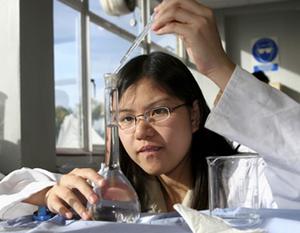STEM educationSchools do not offer students sufficient practical science experience
New evidence shows that a worrying number of students are not experiencing a complete and authentic education in the sciences, due to a lack of resources for practical work. Secondary schools reported not having enough of some of the most commonly used equipment, such as microscopes, eye protection, and connecting leads for circuits. The research also shows that many secondary schools lack essential support from qualified technicians to carry out practical work.

Schools struggle to support practical lab experience // Source: nmu.edu
New evidence shows that a worrying number of students are not experiencing a complete and authentic education in the sciences, due to a lack of resources for practical work.
Research commissioned by SCORE (Science Community Representing Education), a collaboration of leading science organizations, shows that on average, state-funded schools and sixth form colleges have just 70 percent that SCORE has identified as being essential to teach science subjects.
The situation is worse in primary schools, with teachers having access to an average of only 46 per cent of the materials required to teach practical science.
An Institute of Physics release reports that the research is published in two new SCORE reports on resourcing practical science, which were launched 2 May. The data comes from a survey of teachers at primary and secondary schools and sixth form colleges.
Professor Julia Buckingham, chair of SCORE, said: “Taking part in practical work is an integral and essential part of learning the sciences, but our findings indicate that teachers do not feel equipped to give their students the full learning experience that they should be able to. Practical work is being limited by missing equipment and a lack of access to appropriate facilities such as laboratories and outside space.”
Secondary schools reported not having enough of some of the most commonly used equipment, such as microscopes, eye protection and connecting leads for circuits. The research also shows that many secondary schools lack essential support from qualified technicians to carry out practical work.
The situation in primary schools is similarly lacking, with the majority of schools reporting limited access to facilities such as resource areas, dark space and safety equipment.
Both reports reveal some particularly concerning data on the amounts that schools are spending on practical science, which varies greatly from school to school.
In state secondary schools the reported spend in 2011-12 varied from 75 pence per student up to £31.25, while in independent schools funding varied from £7.18 up to £83.21. In primary schools the amount spent varied from just four pence per student up to £19.08.
The reports show some further worrying statistics about science spend in schools
- in state-funded secondary schools, an average of 28 percent of the practical science budget is spent on photocopying
- nearly 70 percent of secondary schools reported that staff had paid for items required for core curricular practical activities out of their own pockets, for which they were not always reimbursed
- in primary schools, 37 percent of teachers stated that they contribute to normal curricular spending from their own money
Professor Buckingham said: “Given the increasing control schools have over their own budgets, some variation in spend between schools is probably to be expected. But the extent of the variation we have seen suggests a worrying inconsistency in the way funding is allocated both to and by schools, which will have a knock-on effect on the experiences of their students.”
She continues: “The evidence shows that, in many schools, practical science is a low priority when it comes to allocating budgets. In secondary schools, nearly half of teachers feel that they don’t have enough funding for practical work and in primary schools nearly a third of teachers feel the same. What is particularly concerning in primary schools though, is that the feedback from teachers indicates that they regard low levels of practical resources as the norm.
“Low resourcing for practical work is a long-term problem and not one that is a simple matter of lack of government funding. Schools must share part of the responsibility for allocating funding for this important aspect of science learning.
“We need teachers to feel that they can make a strong case for practical science spend when school budgets are being decided. So to support them, SCORE has produced a set of benchmarks that provide common guidance on what levels of resourcing should be expected for practical science. These outline the quantities and specifications for equipment and facilities that we consider reasonable to enable teachers to provide engaging and inspirational lessons across the sciences.
“Practical work demonstrates the wonder of science so much more effectively than words on a page or pictures in a textbook. To inspire the next generation of scientists, we need to ensure that all pupils are exposed to the excitement and increased understanding of science that carrying out experiments can bring.”
